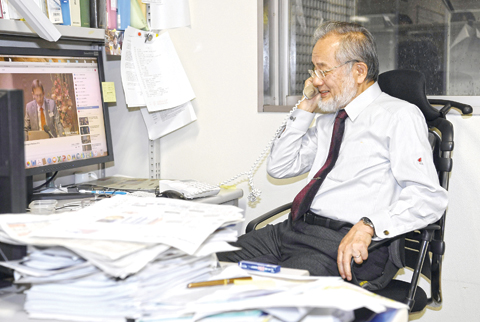 Yoshinori Ohsumi Japanese scientist Yoshinori Ohsumi answers a phone call following a news that he won this year's Nobel Prize in medicine at his office in the Tokyo Institute of Technology campus in Yokohama, south of Tokyo, Monday, Oct. 3, 2016.
Yoshinori Ohsumi Japanese scientist Yoshinori Ohsumi answers a phone call following a news that he won this year's Nobel Prize in medicine at his office in the Tokyo Institute of Technology campus in Yokohama, south of Tokyo, Monday, Oct. 3, 2016.STOCKHOLM: Yoshinori Ohsumi of Japan won the Nobel Medicine Prize yesterday for his pioneering work on autophagy - a process whereby cells “eat themselves” - which when disrupted can cause Parkinson’s and diabetes. A fundamental process in cell physiology, autophagy is essential for the orderly recycling of damaged cell parts and understanding it better has major implications for health and disease, including cancer. Ohsumi’s discoveries “have led to a new paradigm in the understanding of how the cell recycles its contents,” the jury said.
“Mutations in autophagy genes can cause disease, and the autophagic process is involved in several conditions including cancer and neurological disease,” the jury added. Ohsumi told reporters in Tokyo that winning the Nobel “was my childhood dream, but it has not been the focus of my concern since I got into research - I don’t like competing”. Researchers first observed during the 1960s that a cell could destroy its own contents by wrapping them up in membranes and transporting them to a degradation compartment called the lysosome - a discovery that earned Belgian scientist Christian de Duve a Nobel Medicine Prize in 1974.
It was de Duve who coined the term “autophagy”, which comes from the Greek meaning self-eating. In what the jury described as a “series of brilliant experiments in the early 1990s”, Ohsumi used baker’s yeast to identify genes essential for autophagy. He then went on to explain the underlying mechanisms for autophagy in yeast and showed that similar sophisticated machinery is used in human cells. Ohsumi was able to build on de Duve’s work and prove that the lysosome “wasn’t a waste dump, it was a recycling plant,” Karolinska Institute professor Juleen Zierath explained.
Ohsumi’s findings opened the path to understanding the importance of autophagy in many physiological processes, such as how the body adapts to starvation or responds to infection. When autophagy breaks down, links have been established to Parkinson’s disease, type 2 diabetes and other disorders that tend to appear in the elderly. Intense research is now under way to develop drugs that target autophagy in various diseases.
Ohsumi, 71, received a PhD from the University of Tokyo in 1974. He is currently a professor at the Tokyo Institute of Technology. The prize comes with eight million Swedish kronor (around $936,000). “This is the highest honor for a researcher,” Ohsumi told Japan’s public broadcaster NHK. “My motto is to do what others don’t want to do. I thought (cellular breakdown) was very interesting. This is where it all begins. It didn’t draw much attention in the past, but we’re now in a time when there is a bigger focus on it,” added Ohsumi.
The medicine prize is awarded by the Nobel Assembly at the Karolinska Institute, which has seen a shadow cast over its reputation following a recent scandal involving Italian surgeon Paolo Macchiarini. In 2011, while working as a visiting professor at Karolinska, Macchiarini soared to fame for inserting the first synthetic trachea, or windpipe, using patients’ stem cells. His work was initially hailed as a game-changer for transplant medicine. But two patients died and a third was left severely ill.
Allegations ensued that the risky procedure had been carried out on at least one individual who had not, at the time, been critically ill, and in 2014 several surgeons at Karolinska filed a complaint alleging that Macchiarini had downplayed the risks of the procedure. Karolinska suspended all synthetic trachea transplants shortly after and fired Macchiarini. Two members of the Nobel medicine prize assembly were forced to step down in September over the scandal.
The 2016 Nobel season continues today with the physics prize announcement, with the discovery of gravitational waves seen as a potential winner. The first observation of gravitational waves was announced in Feb 2016, a major research breakthrough that confirms one of Albert Einstein’s predictions in his theory of general relativity. The chemistry prize, announced on Wednesday, could go to classic research in the field, with speculation pointing to researchers who added new elements to the periodic table, such as nihonium or moscovium.
On Friday, all eyes will turn to Oslo where perhaps the most prestigious of the awards, the peace prize, will be announced. The Norwegian jury has sifted through an avalanche of nominations this year - a record 376, almost a hundred more than the previous record from 2014. Among those often cited as likely winners are the architects of two historic accords: The recent peace deal in Colombia between the government and the leftist FARC rebels; and the Iranian nuclear deal. But in a shock upset, Colombians on Sunday voted against the peace deal by a razor-thin majority in a referendum. The economics prize will be announced on Oct 10, and the literature prize wraps things up on Oct 13. – AFP










